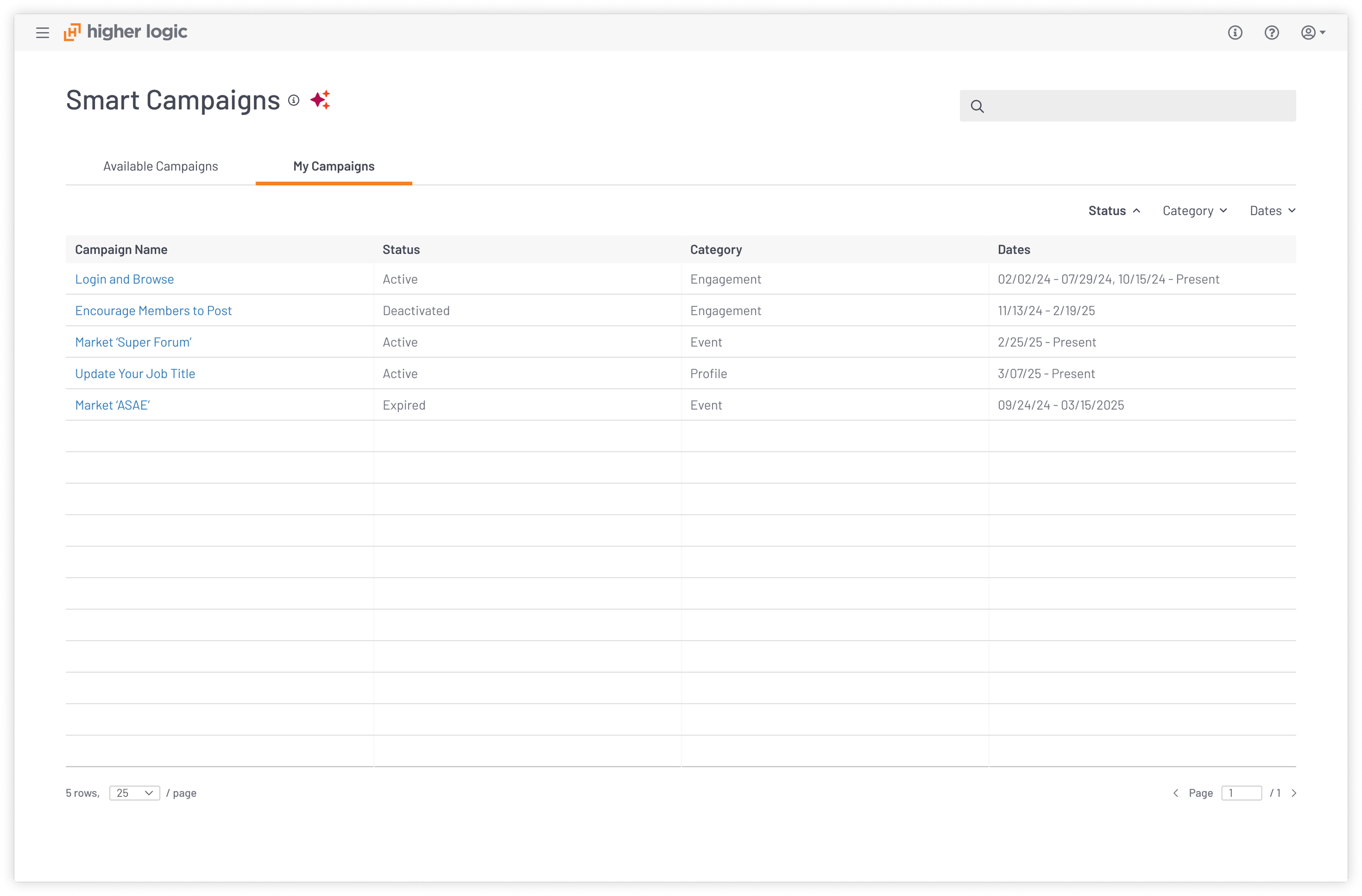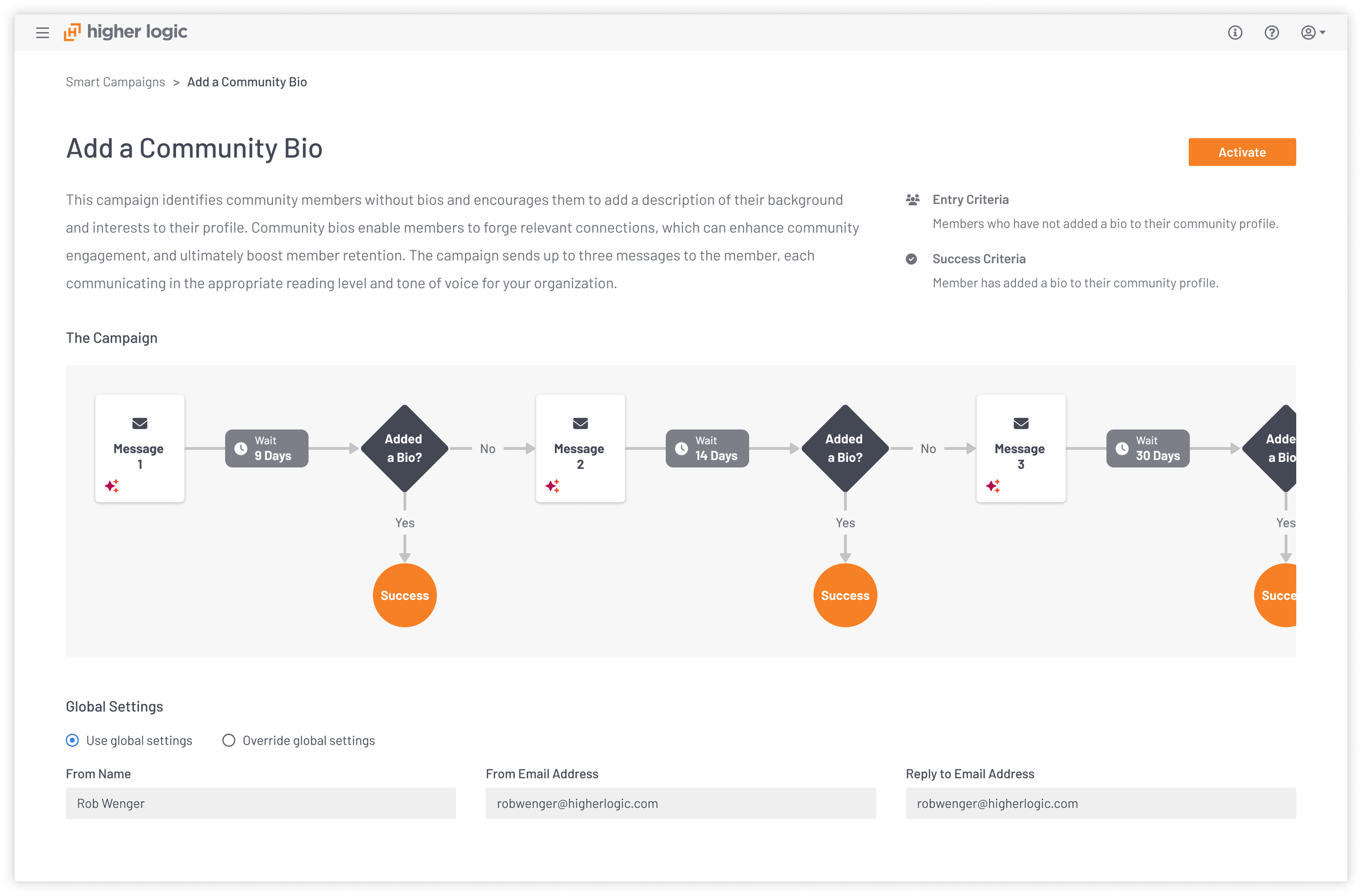Smart Campaigns
Smart Campaigns are AI-powered, predefined marketing campaigns designed to help Community Managers drive engagement in their communities.
-
Lead UX Designer for research, UX, and UI.
-
Higher Logic helps organizations build and engage their online communities. Its suite of community and marketing automation tools empowers customers to strengthen member connections, increase engagement, and drive long-term retention.
-
Higher Logic’s marketing automation product helps member-based organizations create targeted, personalized communications and measure their impact through powerful segmentation and analytics.





Problem & Goal
Community managers are responsible for keeping members engaged, but they’re stretched thin and campaigns are time-consuming to create. As a result, many weren’t realizing the full value of Higher Logic’s marketing product, leading to customer churn. Our goal was to use AI to make campaign creation faster, so busy community managers could engage their communities and realize that value.
Research
I began research by reframing our CEO’s feature request into a clear problem statement: customers were churning because they couldn’t drive engagement with the existing campaigns tool. Facing a tight deadline, I focused research on why that tool failed at-risk users.
Because we couldn’t reach churned customers directly, I interviewed Customer Success and a small panel of active customers to understand the cause of friction and unmet expectations, as well as to explore their attitudes towards AI. This produced a set of insights and an early direction for Smart Campaigns, while I continued refining details as we built.
-
This process require users to build segments in Community and sync them to Marketing to view the contact list. The split systems and complex include/exclude rules makes defining entry criteria unnecessarily frustrating and time-consuming.
-
While associations see the potential efficiency AI can bring to small, resource-strapped teams, their generally conservative nature makes them wary of trusting it. They want full visibility into which parts of a campaign are AI-generated versus provided by Higher Logic, and nothing should reach members without their review and approval. They wouldn’t feel comfortable launching a Smart Campaign without the same level of transparency they’d have if they built it themselves.
-
Community Managers aren’t trained marketers and struggle with how to structure campaigns. They don’t know what campaigns to send, how many emails to include, how often to send them, and how much campaign overlap is appropriate. Without clear guidance, they feel overwhelmed and worry about overwhelming their members.
-
Users found the campaign canvas difficult to wrangle. Steps rarely lined up as intended and too many unused options made the interface more complicated than helpful. Too much freedom made it harder, not easier, to build campaigns.
Key Decisions
Designing Smart Campaigns required making deliberate choices under a fast timeline. Some decisions were grounded in research, while others relied more on my judgment and experience. In both cases, the goal was to balance efficiency with the realities of how community managers work.
-
I chose to split the list of Smart Campaigns into two tabs to better align with user motivations.
Available Campaigns is for browsing and strategizing: large cards sorted by category make it easy to explore areas to drive engagement, addressing the insight that community managers don’t always know what campaigns will help meet their goals.
My Campaigns is for management: a sortable, filterable table helps users track what’s running, turn campaigns on or off, and analyze performance. Searches persist across both tabs, so users can find specific campaigns quickly.
This separation allowed us to optimize each page for its purpose (strategizing versus managing), without forcing one layout to serve both needs.
-
The CEO’s original vision was to showcase the AI by locking text to emphasize its effectiveness and the time it could save. Based on research, I pushed to allow editing. Community managers were cautious with AI and wanted full control over what reached their members. Allowing edits preserved efficiency while respecting their need for oversight and reassurance.
-
It was difficult to find the balance between automation and control. I leaned toward more automation, to make the feature fast and reduce cognitive load by limiting managers to only the most essential decisions. This feature was designed for customers who struggled with regular campaigns, which already offered total customization. I knew the beta would quickly reveal where more control was necessary, while starting with too much would have buried opportunities to simplify.
-
I presented each campaign on a single page and pulled in global settings so users could see every factor that shaped the campaign in one place. I also marked each AI-generated element with an AI icon. This emphasis on transparency gave managers the same level of clarity they’d expect if they built the campaign themselves, helping them feel confident launching even though much of the content was automated.
Smart Campaigns in the Higher Logic Ecosystem
I saw this project as an opportunity to advance my broader UX goal of creating a more seamless connection between the marketing automation and community products to reduce friction and form a continuous loop of engagement.
Working within technical constraints around how data moved between products, I reimagined how campaigns were defined. I introduced predefined and automated entry and success criteria as a workaround to align the two systems without changing their architecture. For example, community managers could automatically target members who had not logged in recently and send personalized emails linking to relevant discussions or events, all without manually syncing data between platforms.
By designing around both user needs and system constraints, I helped close the gap between data and action, making campaigns more effective, driving members back into the community, and strengthening the overall ecosystem.
Beta
We launched Smart Campaigns into a closed beta with 20 customers. I conducted contextual inquiries to see how users interacted with the feature and made decisions. While observing their actions and listening to their thought process, I focused on two critical signals: what stopped them from launching campaigns, which highlighted where more flexibility was needed, and what questions they asked before launching, which showed where greater transparency was required to build trust.
Flexibility – changes that expanded options and reduced constraints
Introduced options to customize the AI’s tone of voice, reading level, and target audience.
Expanded customization for unsubscribe links and email preference management, including support for external links instead of only the default unsubscribe page.
Added a more robust toolbar for text editing, enabling richer styling options.
Transparency – changes that improved clarity and trust
Added a way for users to test campaigns and personalization fields by sending an email to their own inbox, so they could see exactly what members would receive.
Made entry criteria more explicit, clearly detailing what rules created the target group.
Outcomes
Smart Campaigns delivered meaningful impact for customers, the business, and my career. It reduced churn, drove strong early adoption, received overwhelmingly positive feedback from customers, and ultimately laid the foundation for a new product.
Customers
40% adoption within 3 months, with 30% launching 3+ campaigns.
Smart Campaigns received overwhelmingly positive feedback, with customers saying it was simple, clear, and easy to use, and that it made driving engagement much easier.
Business
20% decrease in revenue lost to churn within 3 months.
Smart Campaigns’ success inspired a new product, Thrive Communications, which is a streamlined version of our marketing platform for Community Managers. I am now leading design for this product.
My Career
My impact on Smart Campaigns was recognized company-wide, leading to my promotion to Senior Product Designer.